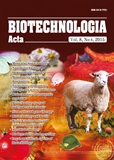ISSN 2410-7751 (Print)
ISSN 2410-776X (Online)

"Biotechnologia Acta" V. 8, No 6, 2015
https://doi.org./10.15407/biotech8.06.016
Р. 16-22, Bibliography 24, English
UDC 602.1:53.082.9
1Institute of Molecular Biology and Genetics of the National Academy of Sciences of Ukraine, Kyiv
2Taras Shevchenko National University of Kyiv
3Institute of Semiconductor Physics of the National Academy of Sciences of Ukraine, Kyiv
4Centre of Intellectual Property and Teсhnology Transfer of the National Academy of Sciences of Ukraine
Research was aimed at the optimization of the urease biosensor for analysis of heavy metals and determining the opportunities of its reactivation. A differential pair of gold interdigitated electrodes deposited on a ceramic substrate was used as the conductometric transducer. As a bioselective membrane served urease, coimmobilized with bovine serum albumin by glutaraldehyde cross-linking on the surface of conductometric transducer. 1.0 mM urea was selected as an optimal substrate concentration for the inhibition analysis of heavy metals. The biosensor was tested for its sensitivity to different heavy metals, the calibration curves were plotted. The proposed biosensor was shown to have high reproducibility of signals prior and after inhibition, the measurement error was less than 3%. It was proved a possibility of reactivation of the bioselective membrane after urease irreversible inhibition by heavy metals, using the ethylenediamine tetraacetic acid solution. The optimum conditions of reactivation, i.e. the dependence of its level on time and concentration of heavy metals, were determined. The additional stage, post-inhibition reactivation, was shown to increase significantly the selectivity of biosensor determination of heavy metals.
Key words: conductometric transducer, biosensor, urease, heavy metals, inhibition analysis, enzyme reactivation.
© Palladin Institute of Biochemistry of the National Academy of Sciences of Ukraine, 2015
References
- Korobkin V.I., Peredelskiy L.V. Ecology. 12-th ed., add. and rec. Rostov n/D: Feniks. 2007, 602 p. (In Russian).
- Evdokimova G.A. Microbiological activity of soils contaminated by heavy metals. Pochvovеdenie. 1982, V.6, P.125-132. (In Russian).
- Alekseev Yu.V. Heavy metals in soils and plants. Leningrad: Agropromizdat. 1987, 142 p. (In Russian).
- Vetoshkin A.G. Processes and mechanisms of hydrosphere protection. Penza: Izd-vo Penz. Gos. Un-ta. 2004, 188 p. (In Russian).
- Kabata–Pendias A. Soil–plant transfer of trace elements — an environmental issue. Geoderma. 2004, 122, 143–149. doi:10.1016/j.geoderma.2004.01.004.
- Song J., Zhao F.J., Luo Y.M., McGrath S.P., Zhang H. Copper uptake by Elsholtzia splendens and Silene vulgaris and assessment of copper phytoavailability in contaminated soils. Environmental Pollution. 2004, 128, 307–315. doi:10.1016/j.envpol.2003.09.019.
- Semenova A.D. Guidance for chemical analysis of surface waters. Leningrad: Gidrometeoizdat.1977, 541 p. (In Russian).
- Yatsenko V. Determining the characteristics of water pollutants by neural sensors and pattern recognition methods. Journal of Chromatography A. 1996, V.722, P.233?243. doi: 10.1016/0021-9673(95)00571-4.
- Lee S-M., Lee W-Y. Determination of Heavy Metal Ions Using Conductometric Biosensor Based on Sol-Gel-Immobilized Urease. Bull. Korean Chem. Soc. 2002, 23(8), 1169-1171. http://dx.doi.org/10.5012/bkcs.2002.23.8.1169
10. Anderson J.L., Bowden E.F., Pickup P.G., Dynamic electrochemistry: methodology and application. Anal. Chem. 1996, 68(12), 379-444. doi: 10.1021/a1960015y.
11. Tran-Minh C. Immobilized enzyme probes for determining inhibitors. Ion-Selective Electrode Rev. 1985, V.7, P.41-75. http://dx.doi.org/10.1016/B978-0-08-034150-7.50006-1
12. Krajewska B. Urease Immobilized on Chitosan Membrane. Inactivation by Heavy Metal Ions. J. Chem. Tech. Biotechnol. 1991, 52(2), 157-162. doi: 10.1002/jctb.280520203.
13. Krajewska B., Zdarta J., Jesinowski T. Enzyme immobilization by adsorption: a review. J. Adsorption. 2014, 20(5), 801-821. doi: 10.1007/s10450-014-9623-y.
14. Zhylyak G.A., Dzyadevich S.V., Korpan Y.I., Soldatkin A.P., El'skaya A.V. Application of urease conductometric biosensor for heavy-metal ion determination. Sensors and Acuators B. 1995, 24-25, 145-148. doi:10.1016/0925-4005(95)85031-7.
15. Dziadevych S.V., Soldatkin O.P. Scientific and technologic foundations for miniature electrochemical biosensors development. Kyiv: Naukova dumka. 2006, 255 p. (In Ukrainian).
16. Shchuvaylo O.N., Danileyko L.V., Arkhipova V.N. Development of carbon fiber based microbiosensors for glucose, acetylcholine, and choline in vivo determination. Biopolimery i kletka. 2002, 18(6), 489-495. (In Russian). http://dx.doi.org/10.7124/bc.00062C
17. Soldatkin O.O., Kucherenko I.S., Pyeshkova V.M., Kukla A.L., Jaffrezic-Renault N., El'skaya A.V., Dzyadevych S.V., Soldatkin A.P. Novel conductometric biosensor based on three-enzyme system for selective determination of heavy metal ions. Bioelectrochemistry. 2012, V.83, P.25-30. doi:10.1016/j.bioelechem.2011.08.001
18. Soldatkin O.O., Kucherenko I.S., Marchenko S.V., Kasap B.O., Akata B., Soldatkin A.P., Dzyadevych S.V., Application of enzyme/zeolite sensor for urea analysis in serum. Materials Science and Engineering: C, 2014, V.42, P.155-160. doi: 10.1016/j.msec.2014.05.028.
19. Kukla A.L., Soldatkin O.O., Pavluchenko A.S., Kucherenko I.S., Peshkova V.M., Arkhypova V.N., Dzyadevych S.V., Toxicity analysis of real water samples of different origin with ISFET multibiosensor. Biochemistry and Biophysics 2014, 2(1), 7-12.
20. Gabrovska K., Godjevargova T. Optimum immobilization of urease on modified acrylonitrile copolymer membranes: Inactivation by heavy metal ions. Journal of Molecular Catalysis B: Enzymatic, 2009, 60(1-2), 69-75. doi:10.1016/j.molcatb.2009.03.018
21. Zaborska W., Krajewska B., Olech Z. Heavy Metal Ions Inhibition of Jack Bean Urease: Potential for Rapid Contaminant Probing. Journal of Enzyme Inhibition and Medicinal Chemistry. 2004, 19(1), 65-69.
doi: 10.1080/1475636031000165023
22. Zaborska W., Krajewska B., Leszko M., Olech Z. Inhibition of urease by Ni2+ ions: Analysis of reaction progress curves. Journal of Molecular Catalysis B: Enzymatic. 2001, 13(4-6), 103-108. doi:10.1016/S1381-1177(00)00234-4.
23. Krajewska B., Zaborska W., Chudy M. Multi-step analysis of Hg2+ ion inhibition of jack bean urease. Journal of Inorganic Biochemistry. 2004, 98(6), 1160-1168. doi:10.1016/j.jinorgbio.2004.03.014.
24. Smoli?ska B., Cedzy?ska K. EDTA and urease effects on Hg accumulation by Lepidium sativum. Chemosphere. 2007, 69(9), 1388-1395. doi:10.1016/j.chemosphere.2007.05.003.

